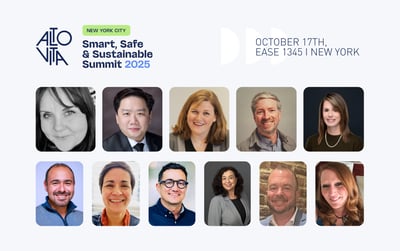

For Day 3 of the final phase of the Corporate Housing Innovation Summit: Product Launch on Wednesday, June 23, we (virtually) traveled to Asia Pacific, where Keryn Mendes, APAC Co-Ambassador and Host of the Working World, led a panel discussion on the Trends Driving the Future of Work & Mobility’s Role. She was joined by industry experts representing the corporate side, mobility strategy, and immigration:
- Stephen Park, Global Mobility Manager at Schneider Electric
- Jamie Lingham, Asia-Pacific Co-Ambassador, Founder & CEO of Absolute Immigration, and Host of the Working World
- Lorraine Jennings, Global Mobility Adviser at Strategy and Design & AIRINC Partner ANZ
Watch the Recording
Introducing AltoVita’s Modular Filter Technology
Vivi Himmel, AltoVita CEO & Co-Founder, conducted a live product demo of one of the five new features built as a result of the Innovation Summit: the greatly enhanced Modular Filter Technology.
We’re giving clients even more power when it comes to sourcing housing for their employees. Now, properties can be filtered for specific features and amenities within new categories: Safety & Security, Family Friendly, Work from Home Ready, Pets, Entertainment, Essentials, and Certifications.
For instance, a client could set up a search for units that check the boxes for gated community (Safety & Security), allow multiple pets (Pets), have ASAP Accreditation (Certifications), and include a baby cot and bathtub (Family Friendly), coffeemaker and laptop-friendly workspace (Work from Home Ready), bicycle (Entertainment), and washer/dryer (Essentials).
And since the filters are modular, a client can add or remove filters at any time – for example, say a washer/dryer is more of a want than a need, it can be later removed from the search.
“That sort of flexibility and freedom is going to enhance the whole mobility experience for the assignee … These sort of things are going to add up to a great experience.” – Jamie Lingham, Asia-Pacific Co-Ambassador, Founder & CEO of Absolute Immigration, and Host of the Working World
AltoVita’s Deeper Integration with Google API
Vivi also showcased the platform’s deeper integration with Google API. So, why did we do this? Because finding a unit with the desired amenities and features is only part of the considerations taken into account for a relocating employee. Another is the benefits of the local area. A digital nomad may want close proximity to grocery stores and coffeeshops, and a parent may want to know there is a school nearby. Thanks to a deeper integration with Google API, clients can now overlay key features on top of a map view: Food & Drink, Shopping, Public Transport, Medical, and Schools. This makes it ever easy for clients and employees to see everything they may want to know, right within the AltoVita platform.
“For me it’s a time saver. It’s so good to have that at your fingertips. It’s fantastic.” – Lorraine Jennings, Global Mobility Adviser at Strategy and Design & AIRINC Partner ANZ
Key Takeaways from the Panel
A word that came up again and again throughout the conversation was “balance.” From the trends of the past 15 months of the pandemic to the forecast for what global mobility is going to be facing in the next year, a key theme how to achieve balance within policies and for the employee as companies adapt to our new normal.
How the Ways of Working Have Changed
To Lorraine’s point, “the biggest changes are less about what we’ve lost and more about what we’ve gained.” COVID has accelerated the broad acceptance of many fringe practices that will last beyond the pandemic – such as online meetings, online ordering, tele-health, and home delivery services. From a mobility perspective, she says, we’ve gained a greater focus on employee wellness, employee choice (ie, working from anywhere – demonstrated live as Jamie dialed in from the car during his work from anywhere adventure across the Outback), and engagement between mobility and stakeholders.
Stephen Park, Global Mobility Manager at Schneider Electric, agreed with Lorraine’s sentiments on how mobility is helping as business advisors, saying, “this is where the mobility industry really stood up to the challenge.” Faced with closed borders and foreign employees in various states of relocation, mobility had to put in steps for wellbeing, safety and security, and get involved with business continuity and help advise on how to manage the complexity.
Border Closures & the Impact on Mobility
Jamie shared that in Australia alone, passenger arrivals decreased 99%, which means the country went from 32 million passenger movements per year down to less than 500,000. There were 2 million overseas foreign nationals in Australia when the pandemic hit, and the government naturally favored their locals and encouraged people to return home. However, Jamie explained, “We found that Australians and permanent residents who were returning home were not actually coming home and being available for jobs. They were continuing to work remotely. So the whole visa situation as well has been absolutely turned on its head.”
Mobility practitioners had to quickly adapt to the evolving crisis and find solutions for mobile employees left in limbo by border closures. There were overseas foreign nationals who were on holiday and then not allowed back into the country they were living in, apartments that were left, animals to move, and a whole range of other new and complex issues that had to be managed.
An easing of the immigration restrictions has begun. Stephen said, “You can still have a certain level of occupations that can work remotely for an indefinite amount of time… but the reality is that in some cases machines still need to be fixed, you still need technicians to come in, business moves on and you still need visas for people to be able to travel. And so what we’ve found globally is that the level of restriction on travel has obviously been high, but slowly governments have started to realize that we need to get people in, we need to replenish the stocks of people who have left [to fill those roles].”
During this time, Stephen encourages mobility practitioners to think about, 1) Is the employee going to be able to get a visa? 2) Are they going to get an exemption to travel to that country? 3) What does quarantine for that country involve and what does it cost? All of these things need to be factored in.
Trend Report
The panel overwhelmingly agreed that the mobility outlook for 2022 is strong. Stephen shared that Schneider Electric’s numbers now are just a little shy of 2019, and he anticipates an increase for 2022. Jamie predicts that “2022 is going to be a frenzy of movement.”
Lorraine is the AIRINC Partner for Australia/New Zealand and shared key findings from their recent 2021 Mobility Outlook Survey:
- It is expected that demand for flexibility in business policies will increase by 56% in APAC (for example, core flex)
- 52% of companies have implemented new policies since the pandemic began, for international remote working, virtual assignments, and short-term assignments
- 48% of companies in APAC are not measuring outcomes, creating a huge opportunity for mobility to demonstrate value
Compliance is Key
All panelists proclaimed the importance of compliance. While having a compliance program in the past may not have been a priority, it certainly should be now. “I think most organizations now that are not reviewing their compliance process, they better do that very quickly,” Stephen said. One of the biggest factors is that compliance and immigration tax has become a revenue-driver for governments.
Jamie stated that while setting up a good compliance program doesn’t take long, making sure you have robust systems, processes, and redundancies in place is key. For instance, when you get an employee’s travel details, share it with mobility but also with finance and other departments to create a redundancy. “So if a payment’s made,” he said, “they can check that all that compliance is in place. Do they have the appropriate visa? Do they have the working rights? Are they working for that company? We’ve all had people turn up and they haven’t had a visa.” This is also an area where vendors could assist through training on a country’s compliance legislation and visa rules.
Stephen added, “If you don’t get it right someone is going to get stuck with a big tax bill, or the immigration program might get shut down in that country – especially if there’s quotas. So there is quite a lot at risk here. [Take the time to] put in the framework.”
Setting Up Mobility Programs
Stephen reminded us that talent is one of the key reasons why mobility exists. Schneider Electric – a company where mobility is in their DNA with a tri-headquartered structure across Paris, Hong Kong, and Boston – seeks to deploy leaders and to develop talent through its mobility program. “These are the people who are going to perform something, learn something, and bring it back,” he says. “So for us mobility is quite an important part.”
But what are the business strategies for another company? The panel agreed that first determining the HR and business objectives and needs is crucial to developing a successful mobility program. Then, a program can be designed that both enhances the employee experience and value proposition, and serves the company.
Stephen posits that there is now going to be a different lens on how companies will attract talent to certain countries. “For example,” he says, “countries with higher vaccination rates will be more attractive to people. I think there need to be more incentives to move people to countries that haven’t had as much success with managing covid.”
The Complex Business of Working from Home and Working from Anywhere
“Of course at first glance remote work seems simple,” Lorraine said, “but it quickly becomes clear it requires broad expertise, and the broad expertise is the HR, the tax, the immigration, the relocation. Mobility already works with each of these stakeholders, so is well positioned to not only own the process but to be able to assist with the policy required.”
While more people are seeking flexible work policies coming out of COVID (and as Stephen pointed out, this percentage may be higher or lower depending on the country you’re in), we can’t forget the benefits of some level of office presence. “For early career, they need to be in the office to have the mentorship. A lot of collaboration happens in the office. In terms of leadership, they need to be around other leaders to have a lot of synergies around that as well.”
Another consideration is employee wellness and preventing burnout, and this goes back to finding the right balance for your company and your workforce. Jamie said, “It’s ranging anywhere from Zoom fatigue to people having a very emotionally tough year last year, and now with school shortages going on, people working additional hours. I’ve heard situations where hotels will only take 70% of their total occupancy because they don’t have the staff to do it and they don’t want to burn out the existing team. That’s going to be a big issue that we’re goin to deal with now into the next 12 months.”
So, how does remote work continue successfully in the future? “I do think digitisation is going to be a stronger factor going forward,” Stephen said. “We need things to be more digital so I don’t have to bother the person on the other side of the world. If I can have access to the same information, there is a lot of efficiency.”
Previous Article
Product Launch Day 2: Europe, Middle East & Africa
Next Article


